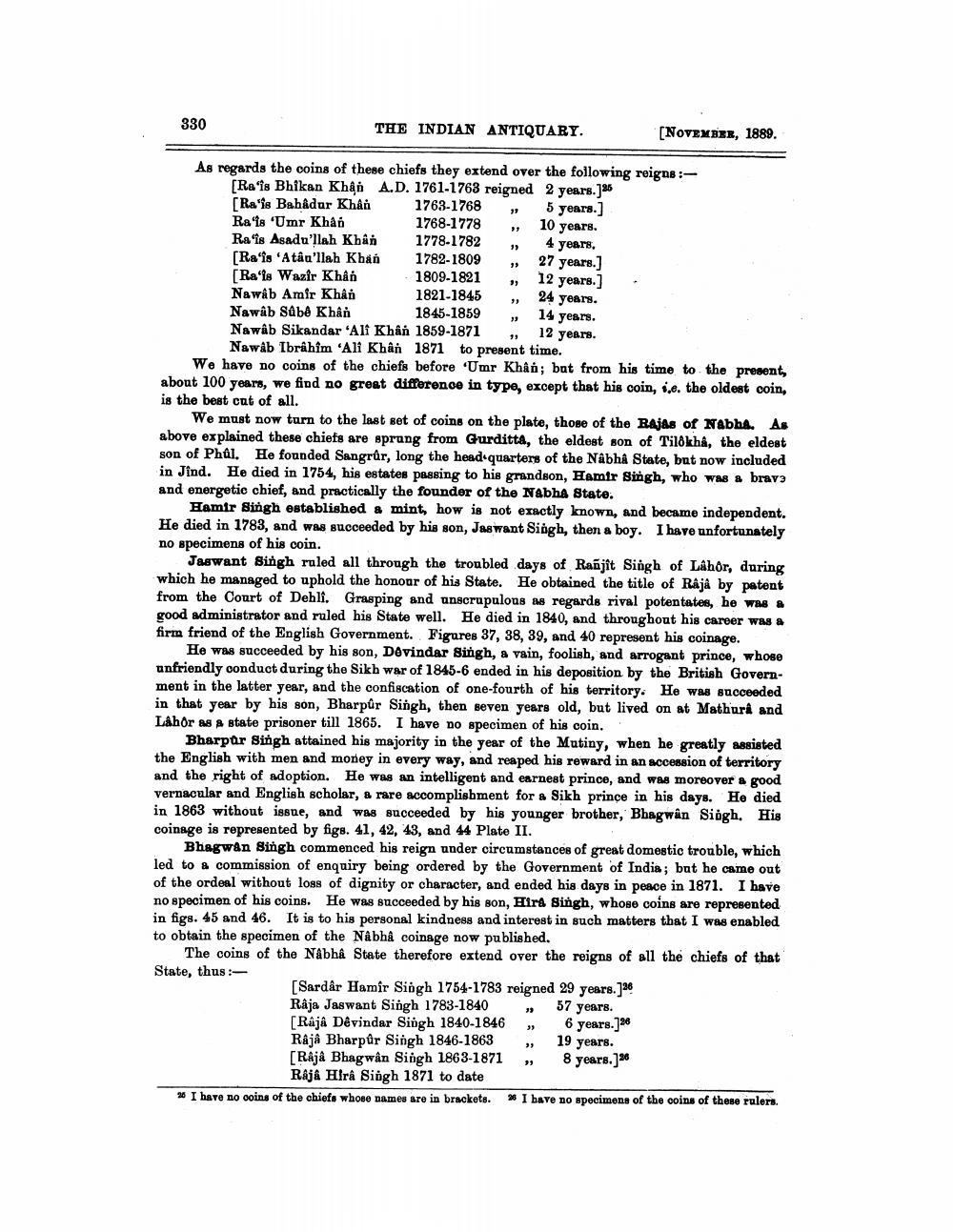________________
330
THE INDIAN ANTIQUARY.
[NOVEMBER, 1889.
As regards the coins of these chiefs they extend over the following reigns :
[Ra'is Bhikan Khan A.D. 1761-1763 reigned 2 years.] 26 [Ra'is Bahadur Khan 1763-1768
5 years.] Ra'ts 'Umr Khan
1768-1778 10 years. Ra'is Asadu'llah Khan 1778-1782
4 years. [Ra'is 'Atâu'llah Khan 1782-1809 27 years.] [Ra'is Wazir Khan
1809-1821 12 years.] Nawab Amir Khân 1821-1845 24 years. Nawab Sabố Khân 1845-1859 14 years. Nawab Sikandar 'Ali Khân 1859-1871 12 years.
Nawab Ibrahim 'Ali Khân 1871 to present time. We have no coins of the chiefs before 'Umr Khân; bat from his time to the present, about 100 years, we find no great difference in type, except that his coin, s.e. the oldest coin, is the best cut of all.
We must now turn to the last set of coins on the plate, those of the Bajas of NabhA. As above explained these chiefs are sprang from Gurditta, the eldest son of Til8khá, the eldest son of Phal. He founded Sangrûr, long the head quarters of the Nâbhâ State, but now included in Jind. He died in 1754, his estates passing to his grandson, Hamir Singh, who was a brave and energetic chief, and practically the founder of the Nabha State.
Hamir Singh established a mint, how is not exactly known, and became independent. He died in 1783, and was succeeded by his son, Jaswant Singh, then a boy. I have unfortunately no specimens of his coin.
Jaswant Singh ruled all through the troubled days of Ranjit Singh of Lahor, during which he managed to uphold the honour of his State. He obtained the title of Rajâ by patent from the Court of Dehli. Grasping and unscrupulous as regards rival potentates, he was a good administrator and ruled his State well. He died in 1840, and throughout his career was a firm friend of the English Government. Figures 37, 38, 39, and 40 represent his coinage.
He was succeeded by his son, Devinder Singh, a vain, foolish, and arrogant prince, whose unfriendly conduct during the Sikh war of 1845-6 ended in his deposition by the British Government in the latter year, and the confiscation of one-fourth of his territory. He was succeeded in that year by his son, Bharpûr Singh, then seven years old, but lived on at Mathuri and Lahor as a state prisoner till 1865. I have no specimen of his coin.
Bharpar Singh attained his majority in the year of the Mutiny, when he greatly assisted the English with men and money in every way, and reaped his reward in an accession of territory and the right of adoption. He was an intelligent and earnest prince, and was moreover a good vernacular and English scholar, & rare accomplishment for a Sikh prince in his days. He died in 1863 without issue, and was succeeded by his younger brother, Bhagwan Singh. His coinage is represented by figs. 41, 42, 43, and 44 Plate II.
Bhagwan Singh commenced his reign under circumstances of great domestic trouble, which led to a commission of enquiry being ordered by the Government of India; bat he came out of the ordeal without loss of dignity or character, and ended his days in peace in 1871. I have no specimen of his coins. He was succeeded by his son, Hira Singh, whose coins are represented in figy. 45 and 46. It is to his personal kindness and interest in such matters that I was enabled to obtain the specimen of the Nâbhâ coinage now published.
The coins of the Nabha State therefore extend over the reigns of all the chiefs of that State, thus:
[Sardar Hamir Singh 1754-1783 reigned 29 years.] 26 Raja Jaswant Singh 1783-1840
57 years. [Raja Dêvindar Singh 1840-1846 6 years.]26 Raja Bharpur Singh 1846-1863 , 19 years. [RAjå Bhagwan Singh 1863-1871 , 8 years.136
Raja Hira Singh 1871 to date * I have no coins of the chiefs whose names are in brackets. I have no specimens of the coins of these rulers.




